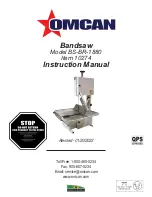
PTS 710 A1
GB
│
IE
│
21
■
f)
Keep cutting tools sharp and clean.
Properly
maintained cutting tools with sharp cutting
edges are less likely to bind and are easier to
control.
g)
Use the power tool, accessories and tool bits
etc. in accordance with these instructions,
taking into account the working conditions
and the work to be performed.
Use of the
power tool for operations different from those
intended could result in a hazardous situation.
5. Service
a)
Have your power tool serviced by a qualified
repair person using only identical replace-
ment parts.
This will ensure that the safety of
the power tool is maintained.
Appliance-specific safety
instructions
Safety instructions for all saws
Sawing method
a)
DANGER! Keep your hands clear of
the sawing area and the saw blade.
Hold the auxiliary handle or motor
housing with your other hand. If you are holding
the saw with both of your hands, neither can be
injured by the saw blade.
b)
Do not reach underneath the workpiece.
The
blade guard cannot protect you from the saw
blade underneath the workpiece.
c)
Set the cutting depth to match the thickness
of the workpiece.
The blade should not extend
more than one full tooth depth under the work-
piece.
d)
Never hold the workpiece that you want to
saw in your hand or over your leg. Fasten the
workpiece onto a stable working surface.
It is
important to fasten the workpiece securely to
minimise the danger of bodily contact, jamming
of the saw blade or loss of control.
e)
Always hold the power tool by the insulated
gripping surfaces when performing an op-
eration during which the cutting tool may hit
hidden wiring.
Contact with a live wire will
also make exposed metal parts of the power
tool live and could give the operator an electric
shock.
f)
When making longitudinal cuts, always use
a rip fence or a straight edge guide.
This will
improve the accuracy of your cut and reduce
the likelihood of the saw blade jamming.
g)
Always use saw blades of the correct size
and with an appropriate central attachment
hole (e.g. star-shaped or round).
Blades that
do not match the mounting hardware of the saw
will run eccentrically, causing loss of control.
h)
Never use damaged or incorrect blade
washers or bolts.
The saw blade washers and
screws have been specially designed for your
saw to provide optimum performance and oper-
ational safety.
Further safety instructions for all
saws
Kickback – causes and corresponding safety tips:
–
A kickback is a sudden reaction caused as a
result of the saw blade catching, jamming or
being falsely aligned that cause the saw to
jump up uncontrollably and out of the work-
piece in the direction of the operator;
–
if the saw blade catches or jams in a narrowing
saw cut, the blade can no longer rotate and the
power of the motor throws the appliance back
in the direction of the operator;
–
if the saw blade twists in the saw cut or be-
comes misaligned, the teeth at the rear edge of
the saw blade can become caught in the sur-
face of the workpiece, causing the saw blade to
jump out of the cut and the saw to jump back-
wards in the direction of the operator.
Содержание 310843
Страница 85: ...PTS 710 A1 82 PL...
















































